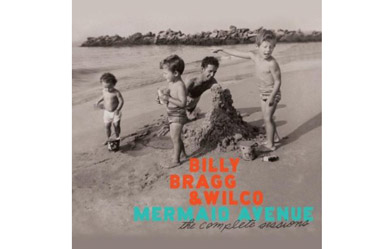Billy Bragg & Wilco
Mermaid Avenue: The Complete Sessions
(Nonesuch)
In the late ’90s, Billy Bragg and Wilco teamed up to put newly discovered Woody Guthrie lyrics to music. Their two Mermaid Avenue volumes are career highlights, brilliantly meshing folk and rock sensibilities. The songs, which focus on such unusual topics as Walt Whitman’s niece, flying saucers, voodoo, and Ingrid Bergman, also helped recontextualize Guthrie as more than just a Dustbowl troubadour. At first glance, The Complete Sessions may seem like another repackaging cash grab, but it’s significant for an hour-long third volume that’s been inexplicably languishing in the vaults. It’s not quite as excellent as its predecessors, but there are plenty of gems, including rousing anti-racism anthem “My Thirty Thousand,” bracing traditional ballad “Go Down to the Water,” and seductive country shuffle “When the Roses Bloom Again.” The set is rounded out by a making of DVD. —Jeff Jackson
*
T-Bird and The Breaks
Dancehall Freakin EP
(independent)
Based in Austin, Tex., The Breaks have a rhythm section, Hendrixian wah-wah guitar and pianos and organs that blend a funk-rock aesthetic with vintage hip-hop. Noho Native T-Bird (Tim Crane) growls bluesy drawls and barks rhymes over a groovy bed with a confident if distanced attitude, and the band/producers also seem to have a thing for weird analog spacey sounds, be they Moogs or vocal effects. Percussion is everywhere (courtesy of fellow Northamptonite Sam “Sammy P” Patlove), and the whole of the mix vacillates between sounding like a riff-loop/gang vocal funk-athon and a locomotive-powered conga groove. The band calls its sound “Chunk” music, which it defines as “characterized by its rough sonic quality and energetic, visceral performance. Commonly served hot with a side of girls and brass.” —Tom Sturm
*
Electric Guest
Mondo
(Downtown)
This L.A. duo offers a strange mix of elements that includes everything from twee electronica to smooth acoustic pop. At times, the youthful tenor vocalizing and upbeat keyboards whip up an unavoidable cuteness—when that arrives, it can be tough to keep listening. The album follows a weird arc, though. Tunes that start fluffy and poppy often morph from pop to something more complex and moody. Such turns make the album a trip of hairpin turns and love/hate moments. That love/hate quality is the album’s strength—the many textures are unexpected, their evolutions sophisticated. That may well come courtesy of the producer, Dangermouse. Electric Guest offers a helium-voiced, futuristic disco dream, unsettling but compelling. Kudos, too, for offering an explanation, via the cover art, for what happened to the Venus de Milo. —James Heflin



